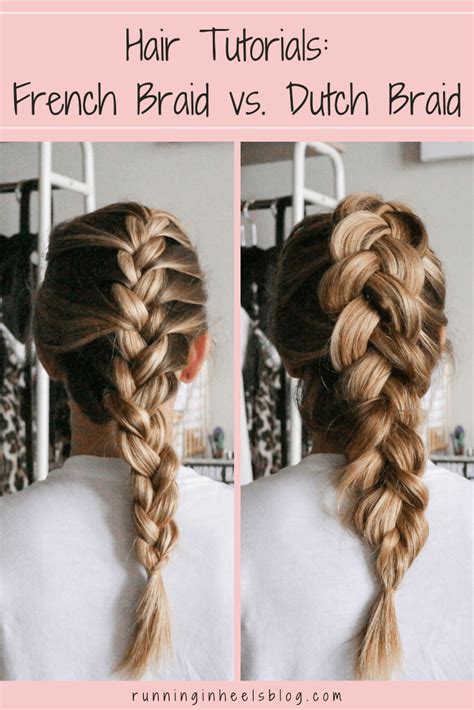A Comprehensive Guide to the Intricate Art of Braiding
Introduction

The alluring charm of braids has captivated hearts for centuries, adorning heads with a kaleidoscope of textures and styles. Among the most renowned braiding techniques reside the French braid and the Dutch braid, two marvels that share a similar lineage yet boast distinct characteristics. This article embarks on an in-depth exploration of these two braiding masterpieces, unraveling their intricacies, similarities, and distinctions to empower you with the knowledge necessary to master their art.
French Braid: A Timeless Classic
Originating in France, the French braid, also known as the “classical braid,” has reigned supreme as a symbol of elegance and sophistication. It is characterized by its intricate intertwining of three strands, interwoven down the length of the hair, creating a smooth and seamless braid.
Historical Significance
The French braid traces its roots back to the Renaissance era, where it was a staple hairstyle among the French aristocracy. Its popularity surged during the 18th century, becoming a hallmark of courtly fashion. By the Victorian era, the French braid had permeated all levels of society, adorning the heads of women from all walks of life.
Pain Points
While the French braid exudes beauty and versatility, it can be a challenge to master, particularly for beginners. The intricate hand movements and constant tension required to maintain the braid’s smoothness can lead to discomfort and even pain. Additionally, individuals with thick or coarse hair may find it difficult to keep the braid secure and prevent it from unraveling.
Motivations
Despite the challenges, the allure of the French braid remains undeniable. Its exquisite appearance and the sheer satisfaction of creating a flawlessly executed braid motivate countless individuals to overcome the pain points and embrace this intricate hairstyle.
Dutch Braid: A Bold and Edgy Statement
Emerging as a Dutch spin-off of the French braid, the Dutch braid distinguishes itself with its bold and eye-catching presence. The key difference lies in the “under-and-over” weaving technique, where strands are crossed underneath rather than on top, resulting in a raised and voluminous braid.
Historical Significance
The Dutch braid, also known as the “inside-out braid,” gained prominence in the Netherlands during the 19th century. It quickly spread to other parts of Europe and eventually found its way to North America, where it became a popular choice for festivals and cultural events.
Pain Points
The Dutch braid, with its underhand weaving technique, can be more time-consuming and challenging to create compared to the French braid. Additionally, the constant tension required to lift the strands upwards and maintain the braid’s volume can lead to discomfort and hand fatigue.
Motivations
The captivating appearance of the Dutch braid, with its voluminous and distinctive texture, drives individuals to overcome the pain points and embrace this bold hairstyle. It is particularly popular among those seeking a statement-making look.
French Braid vs Dutch Braid: A Comparative Analysis
Table 1: Key Differences Between French and Dutch Braids
| Feature | French Braid | Dutch Braid |
|---|---|---|
| Weaving Technique | Over-and-under | Under-and-over |
| Appearance | Smooth and flat | Raised and voluminous |
| Complexity | Moderate | Difficult |
| Time Required | Less | More |
Table 2: Pain Points Associated with French and Dutch Braids
| Pain Point | French Braid | Dutch Braid |
|---|---|---|
| Discomfort | Mild | Moderate |
| Hand Fatigue | Low | High |
| Difficulty | Moderate | High |
Selecting the Right Braid for Your Needs
The choice between a French braid and a Dutch braid ultimately depends on your individual preferences, hair type, and desired outcome.
For Beginners: The French braid is generally easier to master than the Dutch braid, making it a more accessible option for those new to braiding.
For Thick/Coarse Hair: The Dutch braid’s underhand weaving technique provides better hold and support, making it a suitable choice for individuals with thick or coarse hair that tends to unravel easily.
For Special Occasions: Both French and Dutch braids can elevate your look for special occasions. The French braid offers a timeless and sophisticated touch, while the Dutch braid delivers a bold and edgy statement.
Effective Strategies for Mastering French and Dutch Braids
1. Practice Regularly: The key to mastering these braids lies in consistent practice. Practice on different hair textures and lengths to enhance your skills.
2. Use a Rattail Comb: A rattail comb with a pointed tip can help you easily separate and lift strands without tangling them.
3. Start with Smaller Sections: Divide your hair into smaller sections when braiding to make the process more manageable and prevent tangles.
4. Maintain Tension: Keeping consistent tension throughout the braiding process is crucial to ensure a secure and smooth braid.
Common Mistakes to Avoid
1. Overtightening: Avoid pulling the strands too tightly, as this can cause breakage and discomfort.
2. Losing Tension: Failing to maintain tension can result in a loose and sloppy braid.
3. Uneven Strands: Pay attention to the thickness and evenness of the strands you are crossing. Unequal strands can compromise the braid’s symmetry.
4. Crossing in the Wrong Direction: Ensure you cross the strands in the correct direction, over or under, to achieve the desired braiding pattern.
Conclusion
The French braid and the Dutch braid stand as enduring testaments to the intricate artistry of braiding. While they share a common lineage, their distinct characteristics cater to a wide range of preferences and hair types. Whether you seek the timeless elegance of the French braid or the bold statement of the Dutch braid, embracing the techniques outlined in this guide will empower you to achieve flawless and captivating braids that enhance your personal style and elevate your confidence.
